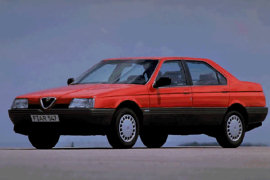ALFA ROMEO 164 Models/Series Timeline, Specifications & Photos
First production year: 1988
Engines: Gasoline, Diesel
Penned by Pininfarina, the 164 was the last true Alfa Romeo designed before the brand's acquisition by Fiat in 1986 but launched in 1987 at the Frankfurt Motor Show.
The Italian automaker started the project in the early '80s, and was a large-sized sedan, by European standards, that targeted the German automakers. Since Alfa Romeo was still poised by the problems of the past with rust and reliability issues, it overcame that and made the 164 with galvanized body panels. The carmaker developed a new platform for its flagship model, which was later on shared by the new owner, Fiat, with Saab and Lancia.
Despite its wedged shape, the 164 boasted a 0.30 drag coefficient, which was remarkable for those years. At the front, the rectangular headlights flanked the grille. The triangular Alfa-shield badge adorned the hood and was quite big, reaching down to the bumper. On the lower side, an apron that featured fog lamps completed the car's sporty look. From its profile, the sculptured doors were unusual in an era where most other vehicles sported flat or slightly curved panels. Those lines were extended toward the tall rear quarter panels, and finally, at the back, the taillights were visually connected by a red strip above the license plate.
Inside, Alfa Romeo installed bolstered front seats and a bench seat profiled for two in the back, even though the car could accommodate five adults. The dashboard followed the wedged shapes and featured a trapezoidal instrument cluster filled with gauges, dials, and warning lights. And there were plenty of them. On the center stack, the automaker placed the HVAC control unit and the stereo. Depending on the options, the 164 boasted a leather-wrapped interior, a sunroof, and power-adjustable front seats.
The car's underpinnings relied on independent suspensions in all corners, making the 164 handles better than most of its competitors. Most versions were fitted with a front-wheel drive system, albeit an all-wheel drive, named Q4, became available in 1993.
ALFA ROMEO 164 2.0L TS 5MT FWD (148 HP)
ALFA ROMEO 164 3.0L V6 24V 4AT FWD (210 HP)
ALFA ROMEO 164 3.0L V6 24V 5MT FWD (210 HP)
ALFA ROMEO 164 3.0L V6 24V Q4 5MT FWD (230 HP)
ALFA ROMEO 164 3.0L V6 24V Q4 6MT FWD (230 HP)
ALFA ROMEO 164 3.0L V6 4AT FWD (184 HP)
ALFA ROMEO 164 3.0L V6 4AT FWD (192 HP)
ALFA ROMEO 164 3.0L V6 5MT FWD (184 HP)
